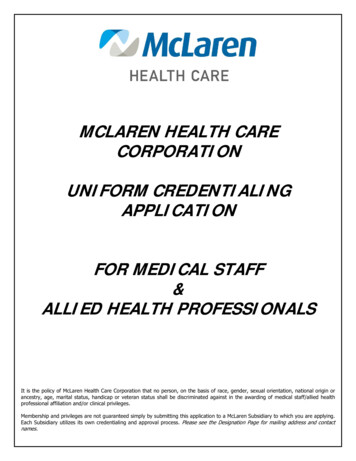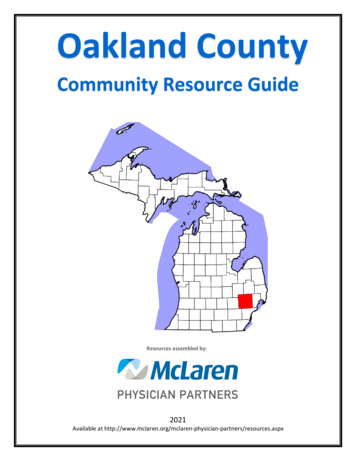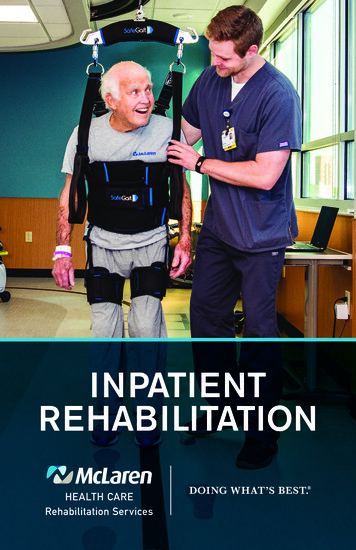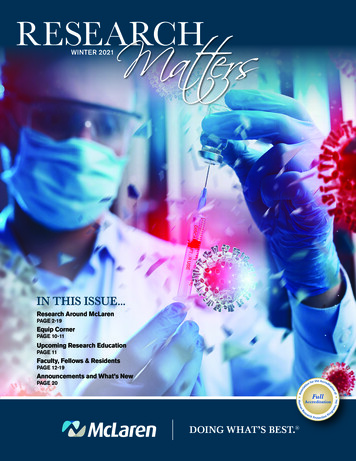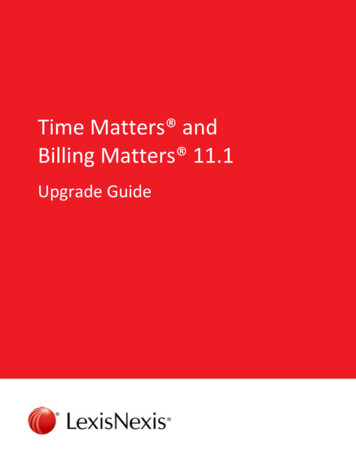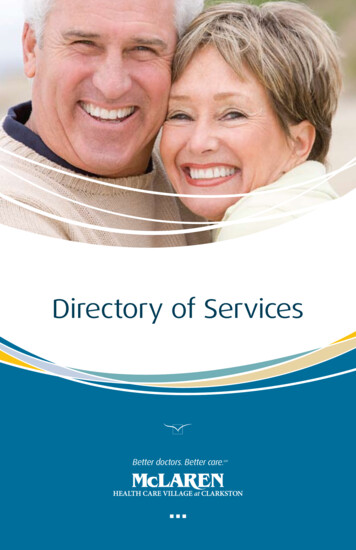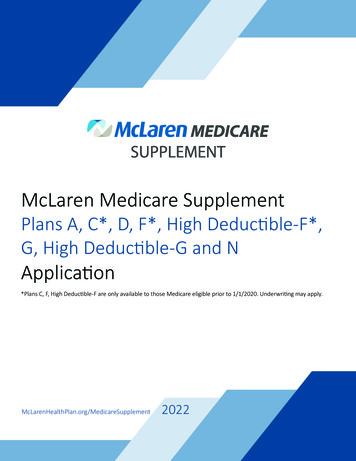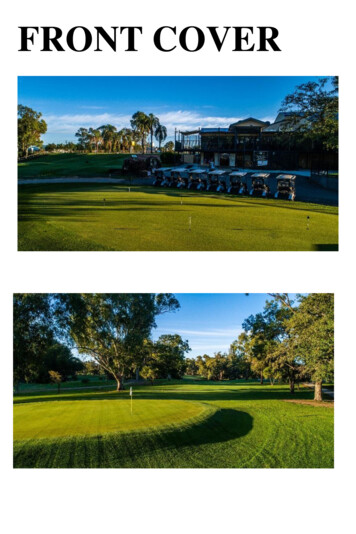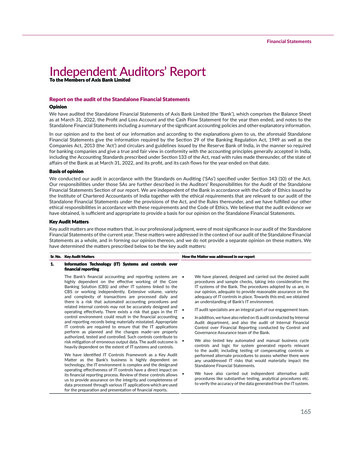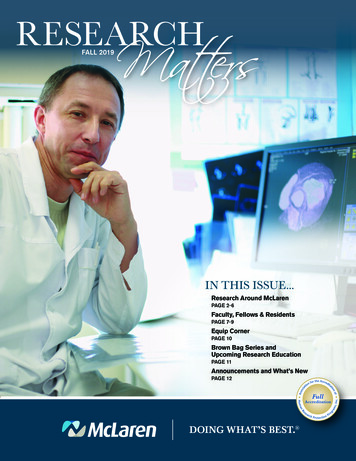
Transcription
MattersRESEARCHFALL 2019IN THIS ISSUE.Research Around McLarenPAGE 2-6Faculty, Fellows & ResidentsPAGE 7-9Equip CornerPAGE 10Brown Bag Series andUpcoming Research EducationPAGE 11Announcements and What’s NewPAGE 12DOING WHAT’S BEST.
Fall 2019 RESEARCH MATTERSRESEARCHAROUNDMcLARENA NOVEL THERAPY FOR PANCREATICNEUROENDOCRINE TUMORSAsfar S. Azmi, PhD, co-leader of the tumor biology andmicroenvironment program at Karmanos Cancer Institute,and assistant professor in the Department of Oncology atWayne State University School of Medicine, has discoveredhow two proteins react to pancreatic cancer cells. The twoproteins, p21 activated kinase4 (PAK4) and nicotinamidephosphoribosyltransferase(NAMPT), play a critical role inthe development of pancreaticductal adenocarcinoma andpancreatic neuroendocrinetumors.Dr. Azmi and his team haveidentified a drug that targetsthese two pancreatic cancersustenance proteins. The drughas shown to be effectiveAsfar Azmi, PhDin blocking the growth ofpancreatic cell lines in patients’ derived tumors.Dr. Azmi’s team has worked aggressively over the last severalmonths to generate a considerable amount of scientific datausing pancreatic neuroendocrine tumor models.Pancreatic neuroendocrine tumors (pNET) account forapproximately 7 percent of all pancreatic tumors. Theydevelop from the abnormal growth of endocrine (hormoneproducing) cells in the pancreas called islet cells. Thesecells play an important role in regulating the body’s bloodsugar levels.“We have found two new therapeutic avenues for thisdifficult-to-treat disease,” said Dr. Azmi.“We have discovered that PAK4 and NAMPT are criticalfor pancreatic neuroendocrine tumor subsistence. Ourteam, working in collaboration with a pharmaceutical, hashelped developed a new drug, KPT-9274, that works asa PAK4-NAMPT dual inhibitor. Our studies show that byblocking PAK4-NAMPT using biological means or throughKPT-9274, we can suppress the proliferation of pancreatic2neuroendocrine tumor cell lines. We are also able todemonstrate the anti-tumor activity in animal models ofpancreatic neuroendocrine tumors.”The data Dr. Azmi and his team were able to obtain fromtheir research was reported in Abstract 4368: PAK4NAMPT Dual Inhibition as a Feasible Strategy for Treatmentof Resistant Pancreatic Neuroendocrine Tumors. Thepaper was shared at the American Association for CancerResearch 2018 Annual Meeting.Thanks to seed funding from the Sky Foundation Inc. andKarmanos’ Partners Night 2018, Dr. Azmi’s team was ableto perform a series of critical experiments that moved hisproject forward. The data obtained from these experimentswas a significant element to support earlier findings. As aresult, Dr. Azmi submitted a grant application to the NationalInstitute of Health/National Cancer Institute for additionalfunding for this work. The grant is currently under review andthe results are expected in late 2019.Dr. Azmi added, “These efforts strengthen the case for theuse of the drug KPT-9274 for the treatment of pancreaticneuroendocrine tumors.”Along with this scientific progress, Dr. Azmi’s lab is in theplanning stages to initiate a Phase I clinical study testing thesafety and efficacy of KPT-9274 in patients with pancreaticneuroendocrine tumors.Dr. Azmi’s team who helped develop this research includeGabriel Mpilla, Amro Aboukameel, Irfana Muqbil, SteveKim, Rafic Beydoun, Philip A. Philip, Ramzi M. Mohammad,Mandana Kamgar, Vinod Shidham, William Senapedis,Erkan Baloglu, Jing Li, Gregory Dyson, Yue Xue and BasselEl-Rayes.“Dedicated team collaboration and funding are both criticalfor the advancement of cancer research that can lead toinnovative treatments and better outcomes for those facedwith this challenging disease.”
Fall 2019 RESEARCH MATTERSTHE INS AND OUTSOF FEASIBILITY REVIEWBy Pam Wills-MertzExamining the feasibility of a research study is essential to its ultimate success.Feasibility review evaluates studies involving human subjects regarding operationaland financial impact. The principal investigator (PI) must ensure they have the time,staff, funding, and other resources to successfully conduct the study. The McLarenCenter for Research and Innovation assesses feasibility by committee review. TheFeasibility Review Committee (FRC) is a multi-disciplinary group designed to assistresearchers in answering the questions often posed regarding their proposedstudy. The FRC is chaired by interventional cardiologist, Mark Zainea, MD, FACC,FSCAI from McLaren Macomb. He is an experienced research clinician and astrong advocate of clinical trials. The FRC members include representatives frompharmacy, supply chain, cath lab and finance, as well as the research team andother service line representatives.ARE YOU INTERESTEDIN BECOMINGA RESEARCHPARTICIPANT?The feasibility review process as led by Dr. Zainea poses many questions thatmust be addressed in order to determine whether the study should be acceptedand moved forward for a scientific review. One question is that of time. Does thePI have adequate time to devote to the study andwill the study be open long enough to enroll theappropriate number of patients? The workload ofthe research coordinator is also assessed for timeand effort requirements. New studies should notjeopardize ongoing research.For information on enrolling in aclinical trial please visit our websiteat https://www.mclaren.org/main/research-trials1.aspx . Here youwill find a list of open enrollingstudies at McLaren, including whichhospital the research is being doneat and contact information for eachstudy.Availability of resources is a common feasibilitydiscussion as we bring on more and more studiesthat involve multiple disciplines such as laboratory,respiratory therapy or nursing. Conversations aboutcoordination of efforts and study logistics must behad prior to feasibility review. Resource evaluationalso includes reviews of equipment or devicesrequired for the study.We have enrolling studies forthe following conditions (not acomplete list): Diabetes High Blood Pressure(Hypertension) Stroke Heart Attacks / Heart Failure /Heart Disease Kidney Diseases Lung Diseases Peripheral Artery Disease Carotid Artery Disease Mastectomy Various Cancers– Breast– Lung– Prostate– Multiple Myeloma Patients who underwentintracranial aneurysm coiling Drug study for patients withrecent acute coronary syndromeMark Zainea, MDAnother area that is evaluated in the comprehensive review of feasibility is thestudy population. Does the site have the correct population to enroll in theproposed study? Is it reasonable to expect that enough patients will agree toparticipate and complete the study during the planned time frame? MCRI entersinto legal contracts with clinical trial sponsors that have an agreed upon enrollmenttarget or number of patients, therefore it is essential to make sure the correctpatient population is available to be screened and enrolled.Finally, budgets and contracts must be reviewed for feasibility. Does MCRI agreeto the terms set forth in the contract by the sponsor? Is there adequate fundingto successfully manage the study? Budget and contract feasibility are additionalmethods of looking at resource utilization. While the PI’s don’t actively get involvedin contract and budget negotiations, the MCRI staff is responsible to ensure thesegoals are met on behalf of the PI.The feasibility review process can be seen by investigators as time-intensive andfrustrating, but it is an essential step in ensuring a high likelihood of study success.Dr. Zainea wants potential investigators to understand “the FRC is not intendedto block research. Our mission is to ensure coordination of resources is adequateCONTINUED ON PAGE 5For a complete list of conditions,please visit our website listedabove.3
Fall 2019 RESEARCH MATTERSRESEARCHAROUNDMcLARENCONGRATULATIONS McLARENNORTHERN RESEARCH TEAM!The MCRI Team at McLaren Northernhad an amazing 3rd quarter. They morethan doubled their patient enrollmentsfrom the prior six-month period andaccomplished this in only three months.The Northern research staff consistsof four coordinators: registered nursesDenise Antonishen, Mary Catton,Colleen Shaw, and Peggy Ward. Thisteam is supported by research assistant,Lisa Rogers.ONCOLOGYRESEARCHPROJECTSOncology related researchconducted at a KarmanosCancer Institute (KCI) locationor throughout the oncologyservice line must be reviewedand approved by the KCIProtocol Review and MonitoringCommittee (PRMC) and allapplicable Institutional ReviewBoards (IRB) prior to activation.A KCI investigator will need tobe involved if research activityoccurs at any of the KCI cancercenter locations. Please contactDr. Gerold Bepler (beplerg@karmanos.org) and Dr. LawrenceFlaherty (flaherty@karmanos.org) if you are interested inactivating an oncology relatedclinical trial or research project.When asked what they attributedthis dynamic quarter to, they reportnumerous factors. One recent changewas a modification to a study thatallowed for an additional population ofpatients to be enrolled. Additionally,three new clinical trials were opened.These trials were some of the first to gothrough the MCRI Feasibility ReviewCommittee and have been found to besuccessful to patient enrollment.Aside from study openings andmodifications is the time and effort ofthe research staff. Currently at McLarenNorthern the research staff screens 12patients to each one that is enrolled.Their efforts to advance medicalscience, as well as improving the healthand well-being of our patients, showsdedication to research.McLaren patients involved in clinicaltrials are often provided choices fortheir care beyond the standard availabletreatment. These treatments wouldnot be possible with the efforts of theclinical research staff. Thank you to theNorthern team!KARMANOS PRESENTS AT AACICLINICAL RESEARCH MEETINGThe Karmanos Cancer Institute Clinical Trials Office had the honor of presentingthree posters at the 11th Annual Association of American Cancer Institute ClinicalResearch Innovation Meeting, July 9 – 11, 2019 in Chicago, Illinois. The posters,featured in the ‘Clinical Research Operations’ and ‘Trial Start-up/Closure’ categories,received great feedback with many attendees mentioning it was great to seeemployees working in groups, taking initiative and leading employees in workplaceengagement and satisfaction. For additional information, please call 313-576-9790.Clinical Trials Office New Study Committee:A Streamlined and Collaborative Approach forClinical Trial Portfolio ManagementSarah Bigelow, CCRP; Kasha Krul, CCRP; MaureenKelley, MSBMS, CCRP; Lisa M. Lange, MSN, ANP-BC,AOCNMultifunctional Staff Focus Groups as a Tool toImprove Employee Engagement of Clinical TrialsOffice StaffL. Lange, AOCN, ANP‐BC; S. Bigelow, CCRP; C.Brown, CCRP; P. Dykema, CCRP; D. Erickson, CCRP; L.JakovskiThe Elephant in the Room –Onboarding of NewStaff in an Evolving Research Landscape Plaguedby TurnoverDina Farhat BS, MS; Jaclyn Ventimiglia BS, CCRP;Elizabeth Horvat BA, MSEd, CCRP; Lindsay CasettaBSBA, CCRP; Joanne Mancini RN, CCRP4
Fall 2019 RESEARCH MATTERSAndrew Jablonowski, ANP-BC,and Maggie Perry, ANP-PC.discusses participation with them. Ifthe participation is agreed upon withthe patient, then they are enrolled in thestudy.”According to the McLaren Centerfor Research and Innovation, theinvolvement of nurse practitioners inthese studies helps to keep the linesof communication open, promotinga strong working team, comprised ofmany members. This not only increasesthe success of clinical trials, but thesuccess of how well patients are caredfor.NURSE PRACTITIONERS’ RESEARCHINVOLVEMENT ON THE RISEResearch is a team effort and involvesa multi-disciplinary team approach tobe successful. Nurse practitioners area vital part of the research process toensure patient experience with researchis positive and streamlined with theirclinical care.McLaren Macomb cardiac nursepractitioner Andrew Jablonowskihas just begun his career journey inresearch. Along with fellow cardiacnurse practitioners, Alissa Clyne andMaggie Perry, he participated in trainingcourses to begin this endeavor.“We are really just beginning research ingeneral as cardiac nurse practitioners atMcLaren Macomb, so everything is fairlynew,” said Andrew. “Alissa, Maggie, andI took research courses to begin ourtraining. We learned how to read theresearch and utilize it effectively, how torun simple research projects and get afeeling for how they operate, and how todo statistical analysis.”“Right now, the three of us have startedby working on smaller trials as subinvestigators in cardiology researchstudies,” he said. “We are starting withvery basic roles and will work our wayup as we gain more experience. Assub-investigators, we work with the PI,as well as with cardiac fellows and otherphysicians. There are two main clinicalresearch trials we are currently workingon. They are the Connect HF study andthe Deliver study.” Both studies are inregard to heart failure.“Our role in these two studies is toidentify specific patient candidatesbased on set criteria that the patient’scondition meets,” he said. “First off,the patient must be an inpatient andhave an acute illness. We review thepatient chart to see if they meet therequirements for the study, and, if theydo, we ask if they have any interestin participating in the study. If theyare interested, we pass the patient’sinformation onto the clinical researchteam, and the study coordinatorAlthough nurse practitioners are fairlynew to the research at McLaren, theyare gaining momentum in the field. “Theidea now is for us to find our way andplace throughout these clinical trialsas they are still very new for us,” saidAndrew. “For now, we remain subinvestigators, but there may be avenuesin the future in which we will look topresent our own studies and becomeprincipal investigators ourselves.”THE INS AND OUTS OF FEASIBILITY REVIEWCONTINUED FROM PAGE 3for study success. The study must befeasible for good research to occur.”A recent potential study was stalled atthe FRC level due to multiple questionsregarding the resources and logisticsof the study. The PI, sub-investigators,research staff and Dr. Zainea met todiscuss the study. The team was ableto smooth out the obstacles and thestudy was then found to be feasible.He further states, “good researchshould never be easy. When humansubjects are involved, there is no roomfor error in research decision making.”5
Fall 2019 RESEARCH MATTERSRESEARCHAROUNDMcLARENDR. STEPHAN PATRICK2019 KALES AWARD WINNERStephan Patrick, PhD, has focused hisresearch on studying how cancer cellsrespond to chemotherapy to improvetreatment options for patients.Dr. Patrick began his PhD program in1994 where he noted, “I was drawnto platinum-based drugs in trying tounderstand how they function anddetermine how cancer cells becomeresistant to therapy.”Dr. Patrick, associate professor in theDepartment of Oncology and memberof the Molecular Therapeutics Programat the Barbara Ann Karmanos CancerInstitute since 2014, and Wayne StateUniversity School of Medicine, hasWAS DRAWN TO“ IPLATINUM-BASEDDRUGS IN TRYINGTO UNDERSTANDHOW THEYFUNCTION ANDDETERMINE HOWCANCER CELLSBECOME RESISTANTTO THERAPY.”— Stephan Patrick, PhDbeen selected as the 2019 winner ofthe Anthony and Joyce Danielski KalesEndowed Faculty Award for InnovativeCancer Researcher.The Kales Award was created in 2012at WSU SOM to recognize exemplaryand innovative cancer research. It issupported by the Drs. Anthony and6Joyce Danielski Kales Endowed FacultyAward for Innovative Cancer ResearchEndowment. Selection is based on acomprehensive review of publishedarticles within the previous year.Dr. Patrick will be honored at Karmanos’Grand Rounds ceremony on October24th in the Hudson Webber CancerResearch Center’s Wertz Auditorium,in Detroit. He will speak about hisresearch, specifically the publicationfor which he is being recognized,“Identification and Characterizationof Synthetic Viability with ERCC1Deficiency in Response to InterstrandCrosslinks in Lung Cancer.”His article was published in the ClinicalCancer Research in 2018.The research was executed by a teamfrom the Molecular TherapeuticsProgram and Biostatistics Core atKarmanos Cancer Institute and WayneState University. His co-authors includeWSU graduate students, Joshua R.Heyza, PhD, and Donovan Watza, PhD;research technicians, Hao Zhang andWen Lei; and faculty colleagues, WeiChen, PhD; Jessica B. Back, PhD; AnnG. Schwartz, PhD, MPH; and GeroldBepler, M.D., PhD.Dr. Patrick and his colleagues identifieda combative way to exploit cancerspecific loss of ERCC1, a DNAendonuclease that plays a criticalrole in mediating platinum-basedchemotherapy response. Many cancertreatments, especially in lung cancer,include a platinum-based regimen, andso it is important to identify biomarkersof platinum-based chemotherapyresponse. Loss of ERCC1 and itsutilization as a biomarker for platinumStephan Patrick, PhDresponse in lung cancers has beeninvestigated previously by numerousresearchers, however, there has beencontroversy and lack of clinical value todate. Importantly, in the study conductedby Dr. Patrick and colleagues, theyuncovered the importance of the p53gene in mediating sensitivity to platinumbased chemotherapy in response tothis ERCC1 deficiency. Also known asthe “tumor suppressor protein,” p53helps control apoptosis and mediatescell-cycle control; however, the lossof p53 uncovers an alternative, errorprone pathway that enables cells totolerate platinum-based chemotherapywith ERCC1 loss. Together, the teamwas able to identify a synthetic viablephenotype in ERCC1-deficient cellswhen p53 is mutated. Of utmostimportance, the team was able toidentify novel drug combinations thatwould overcome the drug tolerance inthe lung cancer cell line models andrestore a hypersensitive phenotype.Collaborating with Dr. Bepler, presidentand CEO of Karmanos Cancer Institute,since the beginning of his career atKarmanos, Dr. Patrick and his teamare avidly working to initiate clinicaltrials, starting with lung cancer andexpanding to other cancers from theresearch conducted. In addition, theyare working to publish a follow-up paperto announce a new drug combination totreat platinum-tolerant cancer cells thatresult in hypersensitization to platinumbased chemotherapy.Dr. Patrick noted that understanding themolecular mechanisms of resistance toDNA crosslinking agents can be linkedCONTINUED ON PAGE 9
Fall 2019 RESEARCH MATTERSNEW ACADEMIC YEAR; NEWFORMS, UPDATES, AND FORMATSMcLaren’s Division of Scholarly Inquiry(DSI) would like to join the McLarenHealth System in welcoming new andreturning residents/fellows/faculty.The new academic year 2019-2020will bring new ideas and scholarlyprojects that will contribute to verticallyadvance health care knowledge andpractice. The DSI is always adaptingand updating its processes to meetthe challenges and demands ofpromoting, facilitating, supporting, andencouraging scholarly activity acrossfive hospitals and over 500 residents/fellows/faculty. The DSI is committedto receive and evaluate the comments,suggestions, and recommendationsof all McLaren staff participatingin graduate medical education. Asa result of this commitment andin appreciation to all of those thatprovided their feedback, the DSI hasdeveloped new forms, eliminatedsome, and updated others for theacademic year 2019-2020.A new Scholarly Activity ReviewCommittee application form has beendeveloped that is shorter, simpler, andwith more and clearer instructions.This new form will replace theprevious one that many residents/fellows/faculty found long, difficult,and cumbersome to complete. Incollaboration with the InstitutionalReview Board, the Determinationof Human Subjects Research andthe Scientific and Scholarly Validityforms have been updated with betterinstructions, improve layout, and nowinclude a PhD signature area as areminder that these forms need to besigned by the PhD prior to emailingthem to the IRB. Another updatewas the addition of hyperlinks to theScholarly Activity Stages’ flowchartwhere ever a form was mentionedin the figure. This flowchart nowalso includes the Protocol ReviewCommittee requirement for prospectiveand interventional studies. Last butnot least, the DSI has developed itsvery own webpage for PhDs to havea one stop place where they can findeverything related to scholarly activity.It is expected that after a period ofthree months and with the feedbackof PhDs, residents/fellows/facultywill have their own Scholarly Inquirywebpage to access everything relatedto scholarly activity on their own.The DSI is also pleased to announcethe development of a new journalclub (JC) format and its successfulpiloting across residency programsin McLaren Oakland. This new JCformat will be implemented systemwide during academic year 20192020. Similarly, the DSI developed anew teaching and training curriculumcontent and sequence focusing onresearch methods, statistics, and otheraspects related to scholarly activity(i.e., electronic searches of the medicalliterature, IRB/ethical requirements,dissemination of scholarly activity,etc.) for residents/fellows using aflipped classroom format that willalso be implemented across theMcLaren system during academicyear 2019-2020. Initial feedback fromresidents/fellows/faculty shows verygood acceptance and relevance.Finally, the DSI has developed anauthorship policy in an effort to clarify,standardized, and prevent conflicts.FACULTY,FELLOWS &RESIDENTSSCHOLARLY ACTIVITYNEWSCarlos F. Rios-Bedoya, ScDIn the Division of Scholarly Inquiry, wehave a commitment and responsibilityto promote, expedite, facilitate, andsupport scholarly activity productivityamong McLaren residents, fellows,and faculty. For additional informationcontact Dr. Carlos F. Ríos-Bedoya atcarlos.rios@mclaren.org7
Fall 2019 RESEARCH MATTERSFACULTY,FELLOWS &RESIDENTS2018-19 RESIDENTS PROJECT AWARDSSCHOLARLY ACTIVITYNEWS(Left to right) Drs. Carlos F. Ríos-Bedoya(Corporate Director of Scholarly Inquiry,McLaren Health Care), GhareebianHagop (Co-author of 1st Place ResidentPoster, McLaren Flint), and Robert F.Flora (Chief Academic Officer & VicePresident of Academic Affairs, McLarenHealth Care) at the 4th Annual MichiganSummit on Quality Improvement, PatientSafety, & Wellness (2019), Troy, MI.McLaren FlintnImplementation of a COPDManagement Plan to ImproveCompliance with Evidencebased GuidelinesMcLaren Greater LansingnAli Ahmad, MD, Ghareebian Hagop,MD, Tryphene Saint-Phard, MD,Lakshmi Kolly, MD, Orimisan S.Adekolujo, MDEmily Henning, DO (MGL OBGYNPGY4) – Now graduated and RobertSeiler DO, FACOOGWon 1st Place for Resident Poster atthe 4th Annual Michigan Summit onQuality Improvement, Patient Safety, &Wellness (2019), Troy, MInThe Return on Investment ofOrthopaedic Fellowship Training:A Ten-Year UpdateMatthew Mead, DO, TheresaAtkinson, PhD, Ajay Srivastava, MD,Norman Walter, MDWon Best Resident Paper at the 2019Michigan Orthopaedic Society AnnualScientific Meeting, Traverse City, MInNo One Should Be Afraid ofthe Water – Somatic SymptomDisorder and Illness AnxietyDisorder in the Aftermath of theFlint Water CrisisSyed Zaidi MD, Erin O’Connor PhD,Megha Garg BS, Prabhat PokhrelMD, PhD, Barbara Wolf PhDWon First Place for ResidentResearch at the American Academyof Family Physician’s Family MedicineExperience, New Orleans, 20188Identification of Risk Factorsfor Surgical Site Infectionsafter Cesarean Section at aSmall Community Hospital: ARetrospective Chart ReviewWon 2nd Place Poster Presentationat the 2019 SCS George W. RussianMemorial Research DaynNovel Technique to AssessGlenoid Bone Loss Compared toTrue Fit Circle Technique UsingMagnetic Resonance ImagingStanley D. Crawford, DO (MGLOrtho-PGY5) – Now graduated,Christopher L Wilcox, DO, NeilOlmscheid, DO, Ryan Fajardo, MD,Patrick Joyner, MD, Jeffrey Knake,M.D., Christopher Dickinson, DOWon 2nd Place Oral Presentation atthe 2019 SCS Orthopedic SurgeryResearch Day
Fall 2019 RESEARCH MATTERSnSingle-Center RetrospectiveAnalysis Evaluating the Safetyand Efficacy of a Pharmacist vsPhysician-Managed InpatientWarfarin Dosing ServiceJason G. Kaplan, MD, Usama Ashraf,PharmD, M. Zeeshan Rizwan,PharmD, Vasim Lala, DOWon 3rd place in clinical vignettes at theMSUSCS Research Poster Competition,May 2019, East Lansing, MIMcLaren MacombnIsolated Pleural Nocardiosis inImmunocompetent MaleAnila Rao, DO, Edward Chi, DO,Kathleen Jahoda, PA-C, DheerajThammineni, MD, Anthony Ognjan,DOWon Case Report Presentation PrizePresented at Michigan OsteopathicAssociation (MOA) Seventh AnnualAutumn Scientific ConventionnA Rare Case of a “BrokenHeart” Causing Papillary MuscleRuptureAnila Rao, DO, Vasim Lala, DO, DonTait, DO, Vivek Sengupta, DO, M.Blair DeYoung, DOWon 1st place for Case ReportPresentation at Michigan OsteopathicAssociation (MOA) 120th AnnualSpring Scientific ConventionMcLaren OaklandnComparison of associatedcomorbid conditions in patientswith benign paroxysmalpositional vertigo with orwithout migraine history: a largesingle institution studyDaniel B. Hilton, DO, Alexander L.Luryi, MD, Dennis I. Bojrab, MD,Seilish Babu, MD, Robert S. Hong,MD, John Zappia, MD, Eric W.Sargent, MD, Olga J. Santiago Rivera,PhD, Christopher A. Schutt, MDWe sincerely regret if we left out anyresident, but we had a publicationdeadline and had some challengesgathering the information from allresidency programs. Nevertheless, ourcongratulations to all of you that receivedany recognition for your scholarly activitywork. We also like to recognize faculty,program directors, and all medicaleducation staff for the support andassistance. Without you, none of thiswould have been possible.Won 2nd Place Oral presentation atMSU-SCS 4th Year ENT ResearchSymposium, April 2019, Novi, MI2019 KALES AWARD WINNERCONTINUED FROM PAGE 6to improving patient responses to platinum-based chemotherapy.“Targeting DNA repair pathways to enhance platinum-based chemotherapy willmake a significant contribution to the treatment of cancers.”Reflecting on his future research, Dr. Patrick mentioned that researchers are“trying to devise new treatment options for the 10 to 15 percent of non-smallcell lung cancers (NSCLC) that are ERCC1 deficient and p53 mutated,and which do not typically respond well to platinum-based chemotherapy.”Furthermore, he noted that adding another drug to the regimen of thispopulation of NSCLC would potentially enhance the effect of platinumbased drugs, which will remain as part of the standard of care. His researchsignificantly influences the chemotherapy options for not just lung cancerexclusively, but for many cancers with low ERCC1, most commonly seen inovarian cancer.Anila Rao, DODr. Patrick added, “To achieve the best response, exploiting the DNA repairdeficiencies in cancer cells and targeting them with specific chemotherapeuticdrugs is critical to the future of platinum-based therapy.”Dr. Patrick will be recognized as the 2019 Kales Award recipient. Hecommented, “I’m shocked, but at the same time I am deeply honored.”9
Fall 2019 RESEARCH MATTERSEQuIPCORNERUSING A NOTE-TO-FILE IN CLINICAL RESEARCHBy Marybeth McCarthyUsing a “note-to-file” (NTF) to relayinformation in research records is avery common practice. In my personalaudit experience, I have noticed anincrease in the use of NTFs. Thishas also been reported in researchliterature. What is the root cause ofthis increase? Is it due to overuseor abuse? Or perhaps just a shift inprocedures. In order to answer thesequestions, we will take a closer look atthe purpose of the NTF, regulations asthey apply to the use of the NTF, andthe appropriate use of the NTF.What is a NTF?A note-to file, also referred to as“memo to file” (MTF), is a documentused to explain or clarify a situationor add information to a file duringthe conduct of a research trial. Forexample, a NTF may document acorrective action, provide missinginformation, explain an action ormistake, provide clarification regardinga discrepancy.What do the regulations and goodclinical practice guidelines sayabout NTFs?Health and Human Services researchregulations and ICH guidelineson good clinical practice (GCP)contain no specific guidance on theuse of NTFs. The Code of FederalRegulations does, however, statethat the investigator is responsibleto maintain adequate, complete andcurrent research records [21 CFR312.62 and 21 CFR 812.140(a)].The ICH GCP (adopted by FDA asguidance) standard on documentation10states that all clinical trial informationshould be recorded, handled,and stored in a way that allows itsaccurate reporting, interpretationand verification. Furthermore, anydiscrepancies in the data collectedshould be explained. In essence,regulations and ICH GCP don’tdirectly address the term NTF, althoughthere is an expectation that informationwill be adequately captured throughoutthe conduct of a study.When is it appropriate to use aNTF?The following are examples of how aNTF can be used to clarify, explain oradd information:nnNoting location of a document, if itis not filed in its designated location(i.e. the delegation log)Explaining a situation occurringwith a specific subject that led to adeviation. For example:– A subject did not take studymedication as directed and failedto document this in the drug diarybecause they did not understandthe directions given to them. ANTF can be used to indicate thatadditional instruction will be givento the subject using the teachback method. In this example theNTF both identified the problem isidentified and provides a solution.– A subject was consented withthe incorrect version of theconsent and it is determined theobsolete version had not beenremoved from the file. A CAPAplan is initiated to reconsent thepatient with the correct versionat the next visit and destroyany remaining unused forms. Inaddition, other subject files willbe reviewed to ensure the correctversion has been used. A NTFcan be generated expl
be successful. Nurse practitioners are a vital part of the research process to ensure patient experience with research is positive and streamlined with their clinical care. McLaren Macomb cardiac nurse practitioner Andrew Jablonowski has just begun his career journey in research. Along with fellow cardiac nurse practitioners, Alissa Clyne and
